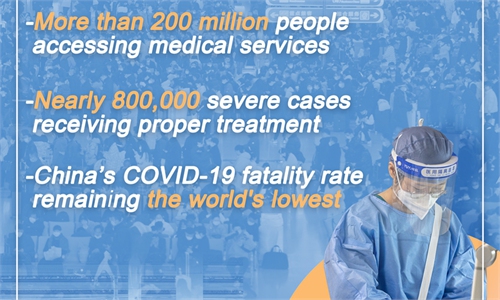WHO decides COVID-19 remains a global health emergency but likely at a transition point; China enters low COVID-19 infection period

File Photo of Coronavirus. Photo: VCG
Director-General of the World Health Organization (WHO) said on Monday that COVID-19 is still an international emergency, three years since the emergency was first announced. Nonetheless, although the pandemic remains at the WHO's highest alert level, it is likely at a transition point.
The WHO's International Health Regulations Emergency Committee held its 14th meeting regarding the COVID-19 pandemic on Friday, after which the WHO Director-General Tedros Adhanom Ghebreyesus has determined that the event continues to constitute a public health emergency of international concern (PHEIC), according to the WHO's statement on Monday.
The Committee agreed that COVID-19 remains a dangerous infectious disease with the capacity to cause substantial damage to health and health systems. At the meantime, it also acknowledged that the COVID-19 pandemic is probably "at a transition point."
The COVID-19 epidemic was declared a PHEIC in January 2020, and was characterized as a pandemic in March 2020. Statistics from the WHO show that more than 6 million people lost their lives in the pandemic.
During the latest meeting, the Committee has recommended that the WHO should develop a proposal for alternative mechanisms to maintain the global and national focus on COVID-19 after the PHEIC is terminated.
"While eliminating this virus from human and animal reservoirs is highly unlikely, mitigation of its devastating impact on morbidity and mortality is achievable and should continue to be a prioritized goal," said the Committee.
Tedros said in December that he hopes to see an end to the emergency in 2023, particularly if access to the countermeasures can be improved globally. But in a separate speech in January, he warned that the virus should not be underestimated.
A piece of the latest positive news is that China, one of the most populous nations in the world, has announced that the country has entered a period of low infection with new cases steadily declining. Epidemic data across the country show a steady downward trend, Mi Feng, spokesperson of China's National Health Commission, said at a news conference on Monday.
The official also stressed that the prevention work in vast rural areas will remain the top priority.
Nearly 80 percent of the population has experienced COVID-19 infection since China optimized its COVID-19 response at the end of 2022, said Wu Zunyou, chief epidemiologist of the Chinese Center for Disease Control and Prevention (Chinese CDC), on January 21.
The Chinese mainland recorded 6,364 COVID-19 deaths in hospitals from January 20 to 26, dropping nearly half compared to earlier week, according to the epidemic-related figures released by the Chinese CDC on Saturday.
According to a report from the Chinese CDC released on Wednesday, multiple COVID-19 statistics have already passed their peaks. Around December 22, 2022, the number of COVID-19 infections and visits to fever clinics across China reached their peak with new infections surpassing 7 million and visits to fever clinics reaching 2.87 million on a daily basis, and the number of deaths reached a daily peak of 4,273 on January 4.
Global Times



